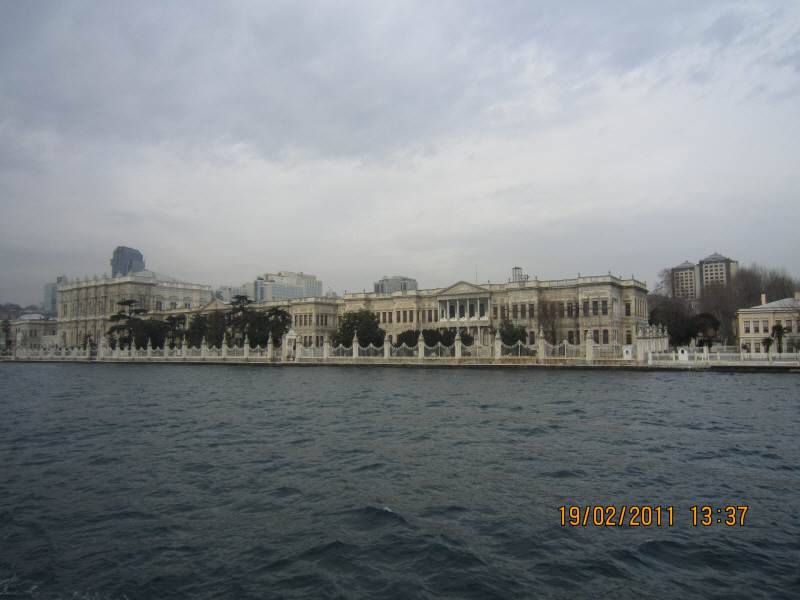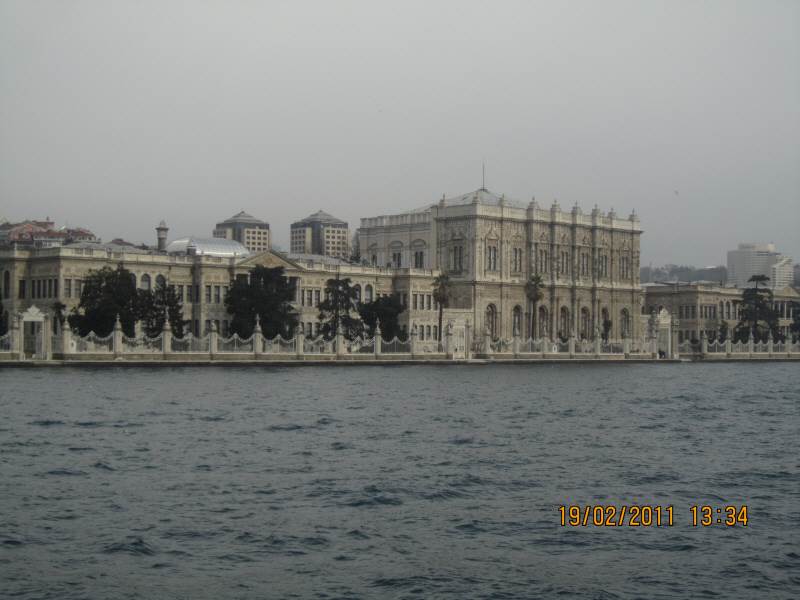Coordinates: Dolmabahçe Palace (Turkish: Dolmabahçe Sarayı, IPA: [doɫmabahˈtʃe saˈɾajɯ]) in Istanbul, Turkey, located on the European side of the Bosporus, served as the main administrative center of the Ottoman Empire from 1856 to 1922, apart from a twenty-two year interval (1887-1909) in which Yıldız Palace was used. Dolmabahçe Palace was ordered to be built by the Empire's 31st Sultan, Abdülmecid I, and built between the years 1843 and 1856. Hacı Said Ağa was responsible for the construction works, while the project was realized by Armenian architects Garabet Balyan, his son Nigoğayos Balyan, and Evanis Kalfa. The construction cost five million Ottoman mecidiye gold coins, the equivalent of 35 tonnes of gold.[1] Fourteen tonnes of gold in the form of gold leaf were used to gild the ceilings of the 45,000 square metre monoblock palace, which stands on an area of 110,000 m².[2][3] The design contains eclectic elements from the Baroque, Rococo and Neoclassical styles, blended with traditional Ottoman architecture to create a new synthesis. The palace layout and décor reflect the increasing influence of European styles and standards on Ottoman culture and art during the Tanzimat period. Functionally, on the other hand, it retains elements of traditional Ottoman palace life, and also features of traditional Turkish homes. It is the largest palace in Turkey, considering that the area of the monoblock building occupies 45,000 m². Previously, the Sultan and his family had lived at the Topkapı Palace, but as Topkapı was lacking in up-to-date luxury and style, Abdülmecid decided to build the Dolmabahçe Palace near the site of the former Beşiktaş Palace on the Bosporus, which was demolished. Whereas the Topkapı has exquisite examples of Iznik tiles and Ottoman carving, the Dolmabahçe palace contains much gold and crystal. Tourists are free to wander Topkapı at their leisure, while the only way to see the interior of Dolmabahçe is with a guided tour. Dolmabahçe Palace was home to six sultans from 1856, when it was first inhabited, up until the abolition of the Caliphate in 1924: The last royal to live here was Caliph Abdülmecid Efendi. A law that went into effect on March 3, 1924 transferred the ownership of the palace to the national heritage of the new Turkish Republic. Mustafa Kemal Atatürk, the founder and first President of the Republic of Turkey, used the palace as a presidential residence during the summers and enacted some of his most important works here. Atatürk spent the last days of his medical treatment in this palace, where he died on November 10, 1938. The world's largest Bohemian crystal chandelier is in the center hall. The chandelier, a gift from Queen Victoria, has 750 lamps and weighs 4.5 tonnes. Dolmabahçe has the largest collection of Bohemian and Baccarat crystal chandeliers in the world, and one of the great staircases has bannisters of Baccarat crystal. The site of Dolmabahçe was originally a bay on the Bosporus which was reclaimed gradually during the 18th century to become an imperial garden, much appreciated by the Ottoman sultans; it is from this garden that the name Dolmabahçe (Filled-in Garden) comes from the Turkish dolma meaning "filled" and bahçe meaning "garden." Various summer palaces were built here during the eighteenth and nineteenth centuries. The palace is composed of three parts; the Mabeyn-i Hümâyûn (or Selamlık, the quarters reserved for the men), Muayede Salonu (the ceremonial hall) and the Harem-i Hümâyûn (the Harem, the residential apartments of the family of the Sultan). The palace has an area of 45,000 m2 (11.2 acres), and contains 285 rooms, 46 halls, 6 baths (hamam) and 68 toilets.[2][3] The famous Crystal Staircase has the shape of a double horseshoe and is built of Baccarat crystal, brass and mahogany. The palace includes a large number of Hereke palace carpets made by the Hereke Imperial Factory. Also featured are 150-year-old bearskin rugs originally presented to the Sultan as a gift by the Tsar of Russia. The palace is managed by Milli Saraylar Daire Başkanlığı (Directorate of National Palaces) responsible to the Grand National Assembly of Turkey. Dolmabahçe Palace Museum is open to public on weekdays from 9:00 to 15:00, except Mondays and Thursdays. A visit to the Dolmabahce Palace begins at the Medhal Hall. Rooms leading off the Medhal are towards the sea and the land. The rooms facing the sea were used by the leading Ottoman officials, the Grand Vizier and the other state ministers, while the rooms facing the land were used by various administrators of the palace and the state, such as the Palace Marshall, Şeyhülislam, and members of the House of Representatives (Meclis-i Mebusan) and the Senate (Meclis-i Ayan). Guests would first wait in this hall and then would be led inside at the proper time by a palace protocol officer. On entering the Medhal, one sees Boulle tables on both sides of the room, which bear the monogram of Sultan Abdülmecid on top. The royal monogram of the sultan is also on the fireplace. The English chandelier hanging in the middle of this room has sixty arms. The Hereke fabrics used as upholstery for the furniture and as draperies are in the royal shade of red. The second room after the Medhal to the right is the Clerk's Hall, also referred to as the "Tiled Room." The largest painting in the palace collection, a depiction of the Surre Procession by Stefano Ussi, hangs on the left wall of this hall. Surre was used to refer to the caravans which travelled from Istanbul to Mecca during the religious month of Recep, bearing the monetary aid used to support the maintenance and the decoration of the Kaaba and to provide financial assistance to the local population of Hejaz. On the wall to the right is a painting signed by the Austrian artist Rudolph Ernst depicting the fire at the Paris Municipal Theater and another painting of a Dutch Village Girl by Delandre. Decorated with French style furniture, this room also contains very valuable porcelain vases. Mustafa Kemal Atatürk, the founder and first president of the Republic of Turkey, spent the last days of his medical treatment in the palace as his health deteriorated. Atatürk died at 9:05 a.m. on November 10, 1938, in a bedroom that is now part of the museum. All the clocks in the palace were stopped and set to 9:05 after his death. Although this has changed recently and clocks are set to different times around the palace, the clock in the room where he died is still pointing to 9:05 a.m.
 Dolmabahçe Palace
Dolmabahçe Palace 41°02′22″N 29°00′06″E / 41.03944°N 29.00167°E / 41.03944; 29.00167
41°02′22″N 29°00′06″E / 41.03944°N 29.00167°E / 41.03944; 29.00167
Dolmabahçe Palace

Dolmabahçe Palace as seen from the Bosporus
Architectural style
Baroque
Town
Istanbul
Country
Turkey
Client
Ottoman sultans
Owner
Turkish state
Started
1843-1856
Architect
Garabet Balyan
Contents
[hide][edit] History
[edit] Architecture
[edit] Medhal (Main Entrance) Hall
[edit] The Secreteriat's Rooms
[edit] Atatürk's room
[edit] Images

Dolmabahce ( Filled-in Garden ) Palace was built by Sultan Abdul Mecit in 1856.
메뉴
2011.03.22 13:02
Dolmabahce Palace on Bosphorus
조회 수 4706 추천 수 0 댓글 0
From Wikipedia, the free encyclopedia
(Redirected from Dolmabahce Palace)
View from the Bosphorus
?














